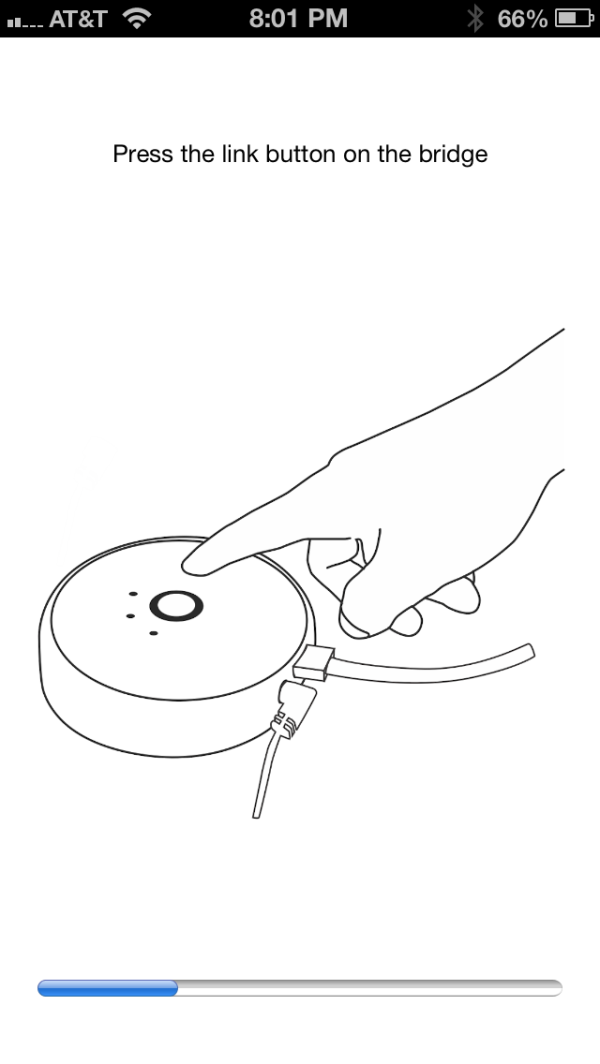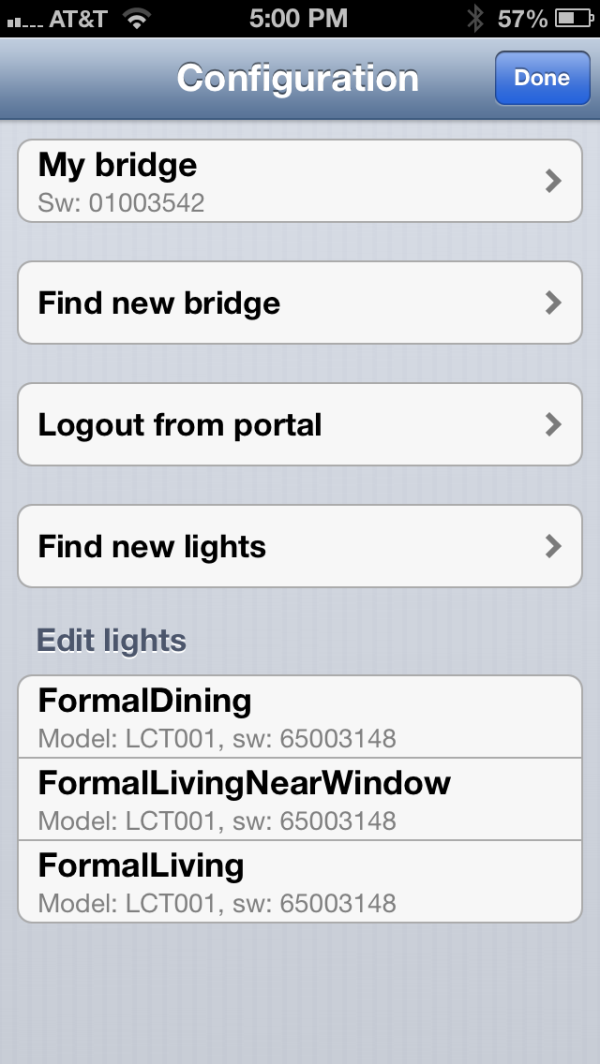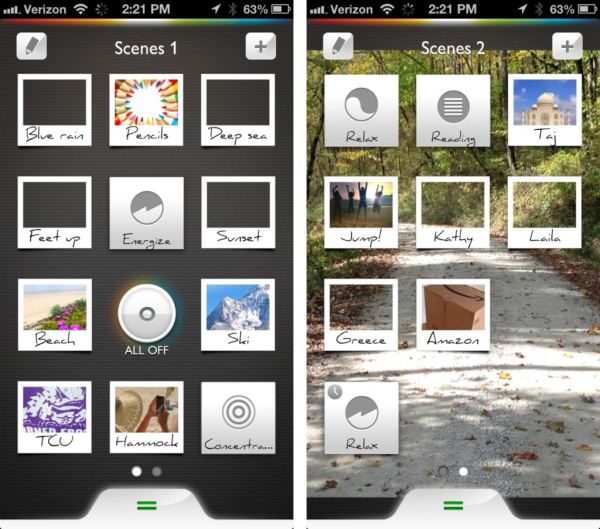Philips Hue: Automated Home Lighting Gets Colorful
by Ashu Joshi on March 1, 2013 12:50 AM EST- Posted in
- Gadgets
- Home Automation
- Philips
- Hue
- Lighting
Philips Hue Setup
The setup process is very easy and at no point do you need a PC or a Mac computer—everything can be done using a Smartphone or a Tablet. The first step for any automation controller that can be controlled over the Home Network or Internet is to get it on the Network, naturally. Philips makes this easy by sticking with Ethernet for the Hue Bridge.
As far as the setup procedure, the first step is to screw in the Connected Bulbs and turn them on. All the bulbs turn on just like normal light bulbs, with a default white light. Once all the bulbs are screwed in and powered on, plug the Hue Bridge into an Ethernet port connected to your home router/gateway and apply power.
The Hue Bridge boots in less than 20 seconds (you can see the boot process in this short video). The next step is to install the app from the Apple App Store on your iOS device (or the Google Play Store for Android).At this point, make sure that your smartphone WiFi is on and connected to your home network. Fire up the app and it will instruct you to press the “link” button on the controller. When you press the button the app discovers the Hue Bridge and you should be ready to go. In my case, it automatically discovered all the three bulbs and they showed up in the app.
From the App settings section it’s possible to rename each bulb to give it a meaningful location. To help with this process, when you select one of the bulbs in the app the corresponding physical bulb starts blinking to show you which light you’re adjusting. This is a handy feature for the initial setup, and it could be even more important if you happen to have a lot of Connected Bulbs.
The app comes with multiple scenes that set the lighting ambience to predefined levels. You can also snap a photo and let the app decide on the appropriate color(s), and you can save all of these settings to new “scenes” (e.g. you might have one setting for a regular dinner with a different settings for a “romantic dinner”). There is also an option in the app to add more Bridges or bulbs, but I have not been able to try that yet. It seems pretty straightforward: adding a new bulb takes you to a page on the Smartphone that instructs you to screw in the new light, turn power on, and start the search.
It’s also possible to control Hue from more than one device (e.g. a tablet, a phone, and maybe the phone of a significant other). The process is as before: download the app, make sure you are on the home network (WiFi), fire it up, and when the app prompts press the “link” button on the Hue Controller and it is paired to the network. (This works very similar to the Sonos app as well.) If you have edited the names of the bulbs (for example I called one of them “FormalDiningLamp”), the other devices will pick up the names as they’re all stored in the Hue Bridge (so thankfully you only have to input the names once).
Controlling the Bridge locally is pretty simple, but if you want to be able to manage the lighting when you’re not at home (e.g. you’re not connected to your home network), you’ll need to create an account on MeetHue.com. Select the “Login to portal” option within the app and it will open up a browser with the account creation page. The page is clearly designed for phones and tablets and after a few guided steps you should be all set. Once you confirm whether you’re using a smartphone or a tablet you can then control the lights from anywhere with Internet access (provided of course that your home network stays up).













94 Comments
View All Comments
Lord 666 - Friday, March 1, 2013 - link
Ok Super Sleuth. On your LinkedIn, does it say you work for the CIA, NSA, or Mossad?Egg - Friday, March 1, 2013 - link
None of those.I'm in high school.
BrokenCrayons - Friday, March 1, 2013 - link
Oh look a new person posting reviews at Anandtech. Let's be big meanie-heads right away instead of saying hi and welcoming someone who's just getting started. That won't make them jaded or plant the seeds that cause them to feel subversively belligerent toward the readers.I, for one, am happy to say, "Welcome Ashu! It's great to see someone new and we look forward to reading your work in the future," even if some people are having a case of the internet grumpy-wumpies.
Egg - Friday, March 1, 2013 - link
I didn't comment on this article - at two in the morning - to flame, troll, deface, or hate on Anandtech. I don't think you can accuse me of that, if you look at my language. If you're somehow offended by "a bit deceptive," "I'm not sure how I feel," and "I don't see Brian Klug posting his reviews on his blog," I apologize. Yet I see far, far, worse elsewhere on this site.So why did I write a comment, when I should have been studying for a test the day after?
I've been a reader of many, many, tech websites: Tom's Hardware, HardOCP, The Verge, Engadget, Silent PC Review, techpowerup, AndroidCentral... the list goes on.
However, there's only one tech website I've continued to read - AnandTech. I read AnandTech because they have some of the most talented people in the industry, Ashu Joshi included. I read AnandTech because it lacks sensationalism and triviality. I read AnandTech because I can be sure everything, short of typos, is correct. I do consider AnandTech to be the "New York Times" of tech journalism.
That's why I believe what is a valid point can and should be raised. Rational people can disagree on many issues, but here's a different question: isn't at least *knowing* how this article came to fruition better than not knowing? As readers who I like to think are a cut above those of other tech sites, we shouldn't simply ignore these details.
Galidou - Saturday, March 2, 2013 - link
''I didn't comment on this article - at two in the morning - to flame, troll, deface, or hate on Anandtech''No one said so.
''I don't see Brian Klugs posting his reviews on his forum''
Well that's maybe becuase he's not new to anandtech...
''I do consider AnandTech to be the "New York Times" of tech journalism. ''
That's your perception, doesn't mean everyone thinks this way, proof of that, someone commented on the fact that this isn't the New york times.
''Rational people can disagree on many issues, but here's a different question: isn't at least *knowing* how this article came to fruition better than not knowing?''
Don't think it makes that much of a difference TO ME, anandtech just gave him more visibility and now that he's working here I guess you won't see much ''duplicates'' on Ashi's blog. The knowledge you tried to add here didn't cut it. Proof of it, most of the replies you had were negatives.
Galidou - Saturday, March 2, 2013 - link
Typo error: Ashu's blog :)JarredWalton - Saturday, March 2, 2013 - link
Just to elaborate on Galidou's response, this is pretty much the way AnandTech functions if you're ever interested in writing for us. Find something you're passionate about and write about it and send it our way. If it's on your blog, that's fine. If the article happens to be about something we haven't covered, we might talk about turning it into an article for AnandTech. As an alternative, do this in the forums and we're looking at the potential for increasing forum post visibility as well.Going forward, once you start writing for AnandTech, we would expect the articles to not be posted/reposted elsewhere, so if Ashu writes about LIFX next it would be an AnandTech exclusive. I don't have a blog for example where I post my AnandTech articles, though I'll sometimes link them and I definitely link them on Facebook. But of course, most of this is up to your discussions with Anand when you sign a writer's agreement...what you're willing to do may be different than what others have agreed to.
Cheers!
Egg - Saturday, March 2, 2013 - link
"No one said so.""Haters gonna hate..."
And the tone of the other responses suggested so.
"Well that's maybe becuase he's not new to anandtech..."
So we should treat different writers with different standards depending on how long they've been writing?
If someone working for a company for 1 year makes the same mistake as someone working for the same company for 20 years, yes, the rookie probably gets off the hook more easily. But they both get their mistakes pointed out just the same.
"That's your perception, doesn't mean everyone thinks this way, proof of that, someone commented on the fact that this isn't the New york times."
Yes, I realize that, that's why I mentioned my opinion that AnandTech is the New York Times of tech journalism. By saying otherwise, you're essentially saying that AnandTech shouldn't have the highest standards possible. Something which AnandTech's About page doesn't seem to support:
"You support us by simply reading the site and we owe it to you to do the best job possible. Our loyalty is ultimately to the readership and not treating you like idiots is the first necessary step to holding up our end of the deal."
"Proof of it, most of the replies you had were negatives."
Voluntary response always holds tremendous bias.
JonnyDough - Tuesday, March 5, 2013 - link
That's all online journalism usually is. Plagiarism. Most blokes online don't even have degrees. People with an education get real jobs!Bladen - Friday, March 1, 2013 - link
Whom is coping whom?Phillips, or LIFX?
http://www.kickstarter.com/projects/limemouse/lifx...